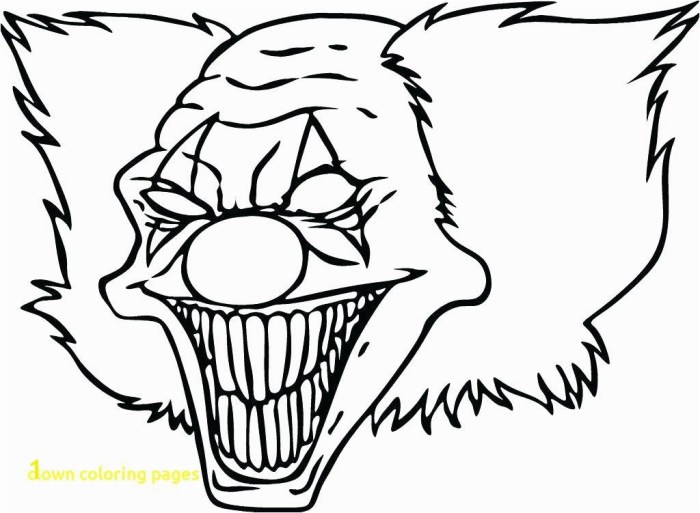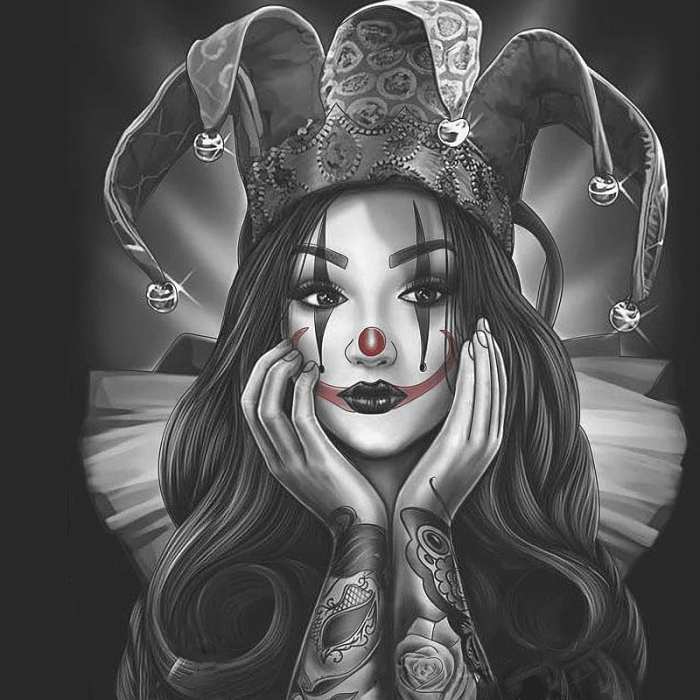Defining “Easy Scary Female Clown Drawing”

So, you want to draw a scary female clown, but you’re aiming for “easy”? Don’t worry, terrifying doesn’t have to mean technically challenging. We’re talking about harnessing the power of suggestion and a few clever artistic shortcuts to create a chilling effect, even with a beginner’s skillset. Think less Michelangelo, more delightfully disturbing nightmare fuel.An “easy scary female clown drawing” prioritizes impactful visual elements over intricate details.
Simplicity is your friend here; it allows you to focus on the core aspects that evoke fear, rather than getting bogged down in realistic rendering. The goal is to capture the unsettling essence of a creepy clown with minimal effort, employing techniques that even a novice artist can master. Think stark contrasts, exaggerated features, and a healthy dose of unsettling atmosphere.
Simplified Drawing Techniques for a Creepy Aesthetic
Achieving a scary effect with simplified techniques relies on strategic exaggeration and the smart use of negative space. Instead of meticulously rendering every strand of hair or wrinkle, focus on creating a general impression of dishevelment and unease. For example, a few jagged, uneven lines can suggest wild, tangled hair far more effectively than a detailed rendering. Similarly, using dark shading around the eyes and mouth can create a sinister look without requiring intricate detail work.Consider using bold, dark Artikels to emphasize key features.
So you wanna draw a terrifying female clown? Piece of cake! Just remember that unsettling grin… then, for a change of pace, try something a little less creepy, like a drawing dinosaur easy te rex ; it’s surprisingly relaxing. Afterwards, you can return to the delightful task of sketching that nightmare-inducing clown’s oversized shoes. It’s all about balance, you know!
A thick, uneven line around the eyes, a sharply defined, exaggerated grin, or even just a single, wickedly curved eyebrow can convey a sense of menace. Keep the color palette limited—think stark contrasts between black, white, and a single, unsettling accent color like a sickly green or deep red. These techniques will amplify the creepy vibe without requiring advanced drawing skills.
Essential Elements for a Scary Female Clown
The key to a truly scary clown lies in the unsettling juxtaposition of childish features with terrifying expressions. Think exaggerated features like a wide, unsettling grin revealing sharp teeth, or large, vacant eyes that seem to follow the viewer. A pale face, contrasting sharply with brightly colored, poorly applied makeup, adds to the disturbing effect. Consider adding elements of decay, like cracked makeup or a single, stray tear, to further enhance the creepy aesthetic.Think about the overall posture and pose.
A slightly hunched figure, with limbs awkwardly positioned, can create a sense of unease. A tilted head, a vacant stare, or a subtly threatening gesture can all contribute to the overall creepiness. Don’t forget the context; a shadowy background, or the suggestion of a dark, unsettling environment, can further enhance the unsettling atmosphere. Even a simple, slightly off-kilter placement of the clown within the frame can contribute to the feeling of unease.
Exploring Different Styles: Easy Scary Female Clown Drawing

So, you want to draw a scary female clown? Excellent choice! The world of terrifying painted smiles is vast and varied, offering a playground for artistic expression that ranges from giggle-inducingly cute to genuinely nightmare-fuel. Let’s dive into the stylistic depths of clown-based terror.Different artistic styles drastically alter the impact of a scary female clown. A cartoonish clown might evoke a sense of playful menace, while a realistic portrayal could be genuinely disturbing.
Surrealism can twist the familiar into something truly unsettling, playing with proportions and reality to create a unique brand of horror. The style you choose dictates the level of fear, the type of fear, and ultimately, the overall effectiveness of your creepy creation.
Artistic Styles and Their Application to Scary Female Clowns, Easy scary female clown drawing
Cartoon styles, with their exaggerated features and simplified forms, can create a surprisingly effective brand of unsettling humor. Think of a clown with comically oversized eyes and a perpetually grinning mouth, but with a sinister glint in those oversized peepers. The contrast between the childish style and the inherent creepiness of the subject matter is what makes this approach work.
A realistic style, on the other hand, aims for photorealism, focusing on detailed rendering of skin texture, hair, and clothing. This approach allows for the depiction of subtle details that can enhance the scariness—a slightly off-kilter smile, unsettling eye makeup, or even a visible scar subtly hinting at a dark past. Finally, surrealism allows for a complete departure from reality.
Imagine a clown with elongated limbs, a distorted face, and perhaps a melting, dripping makeup effect. The unexpected and the illogical can be far more terrifying than a straightforward depiction of horror.
Three Distinct Female Clown Character Designs
Let’s bring these styles to life with three distinct clown characters:First, we have “Giggles,” a cartoon clown. Imagine a brightly colored, almost childish design, but with unsettlingly sharp teeth peeking from behind a wide, painted smile. Her eyes are huge and glossy, yet devoid of any warmth or kindness. Her oversized, brightly colored hair is styled in chaotic curls, and her costume features mismatched patterns and slightly tattered fabric, adding to her unsettlingly off-kilter charm.Next, we have “Veridian,” a realistic clown.
Veridian’s appearance is meticulously detailed. Her makeup is flawlessly applied, but with a subtle, unsettling asymmetry. Her eyes are shadowed and dark, her lips painted a sickly, pale pink. Her costume is a classic, but slightly worn and dirty, suggesting a long and possibly troubled history. Her expression is a neutral mask, almost emotionless, making her even more unnerving.Finally, we have “Meltdown,” a surreal clown.
Meltdown’s features are distorted and elongated. Her face seems to be melting, her makeup dripping down her cheeks. Her limbs are disproportionately long and thin, and her body seems to shift and morph subtly. Her costume is a tattered mess of seemingly incompatible fabrics and colors, reflecting her unstable and unsettling nature.
Color Palettes and Their Impact on Mood
Color plays a crucial role in setting the tone of a scary female clown drawing.For “Giggles,” a bright, almost sickeningly sweet palette works perfectly. Think vibrant pinks, shocking yellows, and electric blues. The contrast between the cheerful colors and the inherently creepy design amplifies the unsettling effect. The palette might include: #FF69B4 (hot pink), #FFD700 (gold), #00FFFF (cyan).Veridian’s palette needs to be muted and somewhat unsettling.
Think desaturated greens, pale pinks, and dull oranges. These colors create a sense of decay and unease. A possible palette might include: #8FBC8F (dark sea green), #F08080 (light coral), #DEB887 (burlywood).Meltdown’s palette should be chaotic and dissonant. A clashing combination of bright and dark colors, with an emphasis on unnatural shades, would enhance the surreal and disturbing nature of the character.
Consider using: #800080 (purple), #000000 (black), #FF0000 (red), and #A0522D (sienna) to create a sense of visual unease.
Background and Composition

Setting the scene is crucial when crafting a truly terrifying clown. The background isn’t just a backdrop; it’s a silent accomplice in your spooky storytelling, amplifying the clown’s inherent creepiness and adding layers of unsettling detail. The right background can transform a simple drawing into a chilling masterpiece.Background scenarios dramatically influence the overall mood and narrative of the drawing.
A well-chosen background enhances the “easy scary” aspect, creating a compelling visual narrative that grabs the viewer’s attention and refuses to let go. The interplay between the clown and her surroundings is paramount in establishing the desired atmosphere.
Background Scenarios
Let’s conjure up three distinct and delightfully dreadful backgrounds for our scary female clown:
First, picture a grimy, rain-slicked alleyway. The brick walls are stained with shadows and the air hangs heavy with the stench of decay. Broken streetlights cast long, distorted shadows that dance and writhe like macabre puppets. A scattering of overflowing trash cans adds to the overall sense of urban blight and despair. Our clown, perched precariously on a crumbling dumpster, seems to be part of the very fabric of this unsettling urban landscape.
The flickering neon sign of a long-defunct pawn shop adds a final touch of chilling desolation.
Secondly, we have a creepy carnival, its once-bright colors now faded and peeling like sunburnt skin. The carousel horses hang limply, their paint chipped and cracked. Twisted balloons, deflated and ghostly white, cling precariously to the rusted metal poles. A lone, flickering lightbulb casts a sickly yellow glow on the scene, highlighting the clown’s unsettling grin as she stands amidst the decaying grandeur of the abandoned funhouse.
The air is thick with the smell of stale popcorn and something else…something faintly metallic and unnerving.
Finally, we have a haunted house, its darkened windows like vacant eyes staring out into the night. Ivy crawls across the decaying facade, obscuring the once-grand architecture. A lone, skeletal tree stands sentinel in the overgrown yard, its branches reaching out like skeletal fingers. The moon casts long, distorted shadows, adding to the overall feeling of dread and unease.
Our clown is positioned near a broken window, her shadow stretching long and menacing across the crumbling stonework. The faint sound of creaking floorboards and the distant howl of the wind only amplify the eerie silence.
Clown Placement and Compositional Impact
The placement of the clown within the composition is vital. A centrally positioned clown, staring directly at the viewer, creates a confrontational and intensely unsettling effect. Conversely, placing the clown off-center, lurking in the shadows, generates a sense of mystery and unease. A strategically placed clown can use the background elements to their advantage, enhancing the overall impact of the drawing.
For instance, a clown partially obscured by shadows or partially hidden behind an object creates a sense of mystery and anticipation.
Visual Description of a Suitable Background
Imagine a dimly lit, overgrown graveyard. The moon hangs low in the sky, casting long, distorted shadows across the weathered tombstones. A thick fog rolls in, obscuring the edges of the scene and adding to the eerie atmosphere. The only source of light is a flickering lantern held by the clown herself, casting an unsettling glow on her painted face and highlighting the details of her grotesque costume.
The overall color palette is muted and dark, with shades of gray, black, and deep purple dominating the scene. The atmosphere is heavy with a sense of foreboding, creating a perfect backdrop for our easily scary female clown.
FAQ Resource
What materials are needed for this drawing?
Pencil, eraser, paper, colored pencils or paints (optional).
How can I make the clown look more menacing?
Use sharp, angular lines, exaggerated features (eyes, mouth), and a dark color palette.
What if I’m not good at drawing?
Start with simple shapes and gradually add details. Practice makes perfect!
Can I use this drawing for a Halloween project?
Absolutely! This drawing style is perfect for Halloween decorations or costumes.
Where can I find more inspiration for scary clown drawings?
Search online for “scary clown art” or “creepy clown images” for countless examples.
